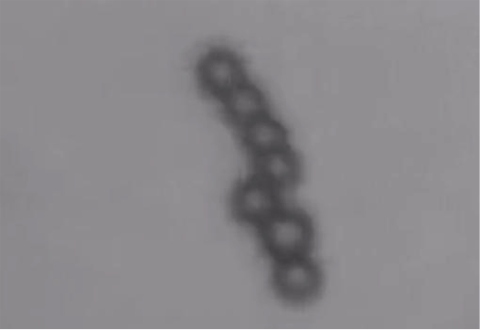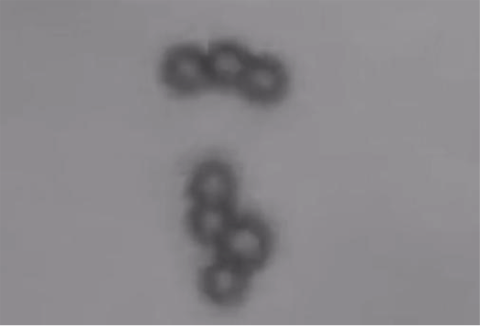Tiny Robots Swim Toward Better Healthcare
August 2, 2016
Tiny swimming robots could revolutionize healthcare, traveling through the bloodstream and delivering medicine precisely to where it needs to be, performing surgery, and even unclogging arteries. The possibilities are so exciting that multidisciplinary teams of engineers and scientists around the world are earnestly working on creative ways to meet the challenges involved.

Microswimmer robots, resembling a chain of beads, can be made to move through a liquid by a rotating magnetic field. New research shows how they can split into separate operable robots and then reconnect.
Image Credit: Southern Methodist University
Microorganisms like flagellated bacteria swim through the body in an entirely different way than Michael Phelps and Katie Ledecky speed through a pool. Shrink down to the size of bacterium and you’ll see why. Swimming objects on the scale of microorganisms experience a different physical situation than you and I do, even in water. For them, traveling through water is more like what swimming through honey would be like for us. That means we can’t just apply the swimming techniques of humans, or even fish, to microscale robots—we need new techniques. If Olympic pools were filled with honey, you can bet swimmers would use techniques other than the breaststroke and the butterfly.
Another challenge is control. This technology is only effective if microrobots can reliably reach precise locations within the body. What’s the best way to control their motion? Beyond this, how do we program these tiny robots to do the tasks that need doing? Ideally, microrobots would be capable of completing several different tasks, otherwise we need uniquely designed microrobots for each different application which means more time and money.
Scientists and engineers have made significant progress in meeting these challenges and bringing this technology closer to reality. In the last couple of years, scientists have created flexible, soft microrobots that change shape with heat and are controlled with electric fields, worm-like microrobots that propel themselves under patterns of green light, and a micro-scallop that can swim by itself, among others
Recently, researchers led by Prof. MinJun Kim from Southern Methodist University (formerly at Drexel University) and Prof. Henry Fu at the University of Utah demonstrated that swimming modular microrobots can be made from tiny magnetic beads that can be linked, unlinked, and propelled using rotating magnetic fields. Their discovery and explanation of the theory behind it could bring us one lap closer to versatile swimming microrobots that can diagnose, treat, and heal. This research was published in Scientific Reports on July 28, 2016.
Modular Microrobots
Microorganisms travel through the body in a variety of ways, via different shapes and propulsion mechanisms that depend on their destination and goals. Ideally, microrobots should be able to travel through different physical environments within the body, such as through the bloodstream and cancerous tumors, and to perform various tasks. One way to instill this versatility is to design robots that can change shape and speed while swimming.
With this in mind, a team led by Kim created simple, tiny robots called microswimmers made of modular pieces—spherical, magnetic beads. Like magnetic toy trains, the balls can be linked together in chains of different lengths. It turns out that these chains have different physical properties depending on their length, and that their length and movement can be controlled by an external rotating magnetic field.
Controlling Motion
Scientists and engineers have developed several different ways to control microrobots, but magnetic fields usually come out on top. Perhaps you’ve played the game where you push or pull on a magnet by bringing another magnet close by, but not letting them touch. If so, you know that a strong magnetic field applies a strong force on a nearby magnet that can make it move. Magnetic fields are an effective way to control objects inside of the human body from outside of the body. They work over long distances (as long as the field is strong enough), don’t damage the body, and are pretty powerful.
For this set of experiments, the researchers placed microswimmers inside of a sealed container, 3mm x 2mm x 2mm, and put the whole thing inside of a rotating magnetic field. In the presence of a rotating magnetic field, a microswimmer moves like a corkscrew, spinning around and moving forward at the same time. In general, a faster rotating field leads to faster swimming.
In addition, experiments showed that microswimmers of different lengths have different swimming properties. Most notably, longer ones swim faster. The longest microswimmer the team tested consisted of 13 beads and reached a speed of about four miles per hour.
Linking and Unlinking
One of the main advantages of using a modular system is that you can use the same building blocks to build microrobots of different lengths. Most of the swimming microrobots in existence are tough to link and unlink. However, the use of spherical beads makes this process much easier.
What makes this new system even more advantageous is that you can change the length of the microswimmer even while it is swimming by linking or unlinking beads. That means that you can change the speed and shape of the chain at any time, enabling the microswimmer to adapt to different environments it might run into in the body. It also means that you can send one microswimmer into the body controlled by one magnetic field, and then split it into two microrobots that can perform different tasks.

By splitting the microswimmer robot chain into separate actuated robots, multiple tasks can be completed at once. This makes them ideal for surgery and targeted drug delivery.
Image Credit: Southern Methodist University
Experimentally, the team found that you can link a microswimmer to an individual bead by physically moving the microswimmer toward the bead until they come in contact. This worked pretty well, but not all the time. In order to better understand the mechanism behind the linking process, their collaborators, led by Fu, set to work on a mathematical model of the physics behind it.
By modeling the magnetic interactions between the beads and the rotating magnetic field, the beads' interactions with each other, the properties of the fluid, AND the swimming motion, the researchers found out why attempts to join microswimmers with individual beads worked sometimes, but not always. It turns out that there are certain areas of repulsive forces around a microswimmer. If a microswimmer approached a bead in such a way that the bead was in its “repulsive area”, the bead wouldn’t link up. If, however, the angle of approach was changed slightly so that the bead was in an attractive area around the swimmer, it had no problem joining up. Experimental tests of this model showed that the researchers were on the right track, and the team was able to optimize its strategy for linking beads.
Not only can a microswimmer grow, it can also divide. This has nothing to do with the attractive and repulsive areas that control linking, unlinking depends on the rotating magnetic field. The researchers found that at certain rotation rates, a twisting effect caused the chain to split. Experimentally, they were able to control the swimming motion of two microswimmers of different lengths independently after an initial swimmer split.
Want to see it in action? Check out this video of the microswimmers growing and splitting.
Looking Forward
This technology could have a wide range of medical applications, but at the top of the list is unblocking arteries. The SMU researchers are part of an international partnership of 11 institutions focused on developing a microrobot-based procedure for clearing blocked arteries within the next five years, a research initiative funded by the Korea Evaluation Institute of Industrial Technologies.
Controlling the motion of a microswimmer in a small, sealed dish is a lot different from controlling its movement through the human body to a precise location and performing lifesaving tasks. However, reaching that goal requires a thorough understanding of how microrobots interact with one another and swim. These little swimmers may not have the smooth glide and record-breaking speed of world champions, but they just might be able to take the sport to a whole new level.
—Kendra Redmond














